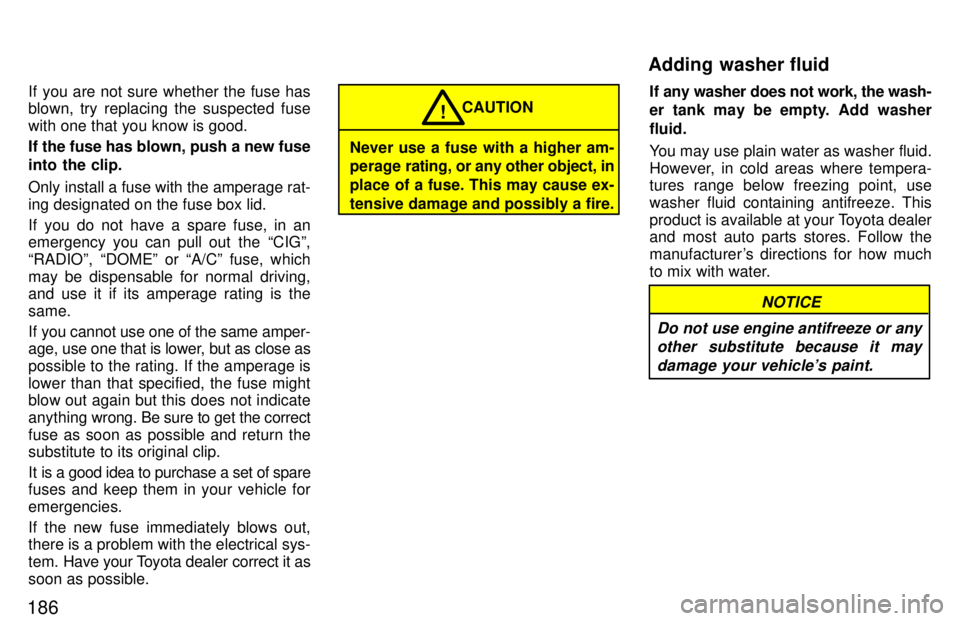Page 189 of 212
185
NOTICE
Never recharge the battery while the
engine is running. Also, be sure all
accessories are turned off.
If the headlights or other electrical
components do not work, check the
fuses. If any of the fuses are blown,
they must be replaced.
See Fuse locationsº in Chapter 7-1 for
locations of the fuses.
Turn the ignition switch and inopera-
tive component off. Pull a suspected
fuse straight out and check it.
Determine wh ich fuse may be causing the
problem. The lid of the fuse box shows the name of the circuit for each fuse. See Part 8 of this manual for the functions con-
trolled by each circuit.
Type A fuses can be pulled out by the pull-
out tool.
Checking and replacing fuses
Page 190 of 212

186If you are not sure whether the fuse has
blown, try replacing the suspected fuse with one that you know is good.
If the fuse has blown, push a new fuse
into the clip.
Only install a fuse with the amperage rat-
ing designated on the fuse box lid.
If you do not have a spare fuse, in an
emergency you can pull out the CIGº,
RADIOº, DOMEº or A/Cº fuse, whichmay be dispensable for normal driving, and use it if its amperage rating is the same.
If you cannot use one of the same amper-
age, use one that is lower, but as close as
possible to the rating. If the amperage is
lower than that specified, the fuse might
blow out again but this does not indicate
anything
wrong. Be sure to get the correct
fuse as soon as possible and return the
substitute to its original clip.
It is a good idea to purchase a set of spare
fuses and keep them in your vehicle for emergencies.
If the new fuse immediately blows out, there is a problem with the electrical sys-
tem. Have your Toyota dealer correct it as
soon as possible.
Never use a fuse with a higher am-
perage rating, or any other object, in
place of a fuse. This may cause ex-
tensive damage and possibly a fire. CAUTION
!
If any washer does not work, the wash-
er tank may be empty. Add washer fluid.
You may use plain water as washer fluid.
However, in cold areas where tempera-
tures range below freezing point, use
washer fluid containing antifreeze. This
product is available at your Toyota dealer
and most auto parts stores. Follow the
manufacturer 's directions for how much
to mix with water.
NOTICE
Do not use engine antifreeze or any other substitute because it may
damage your vehicle's paint.
Adding washer fluid
Page 191 of 212

187
NOTICE
5VZ-FE engine vehicles for Canada:
When adding washer fluid, be careful not to spill the fluid over thedaytime running light resistor.
The following illustrations show how to
gain access to the bulbs. When replacing a bulb make sure the ignition swithc and
light switch are off. Use bulbs with the wattage ratings given in the table.
Halogen bulbs have pressurized
gas inside and require special han-
dling. They can burst or shatter ifscratched or dropped. Hold a bulb
only by its plastic or metal case. Do
not touch the glass part of a bulb
with bare hands. CAUTION
!
NOTICE
Only use a bulb of the listed type.
Light bulbsBulb
No.WType
Headlights900360/55A
Parking lights1685C
Front turn signal lights115627B
Rear turn signal lights115627B
Stop and tail lights115727/8B
Back-up lights115627B
High mounted stop- light1685C
License plate lights1685C
Interior lightÐ8D
Personal lightsÐ5D
Glovebox lightÐ5C
Step lightsÐ5C
A: HB2 halogen bulbs B: Single end bulbs
C: Wedge base bulbsD: Double end bulbs
Replacing light bulbsÐ
Page 197 of 212
Part 8193
SPECIFICATIONS �
Dimensions and weight
�Engine
�Fuel
�Service specifications
�Tires
�Fuses
Page 199 of 212

195
Model:
3RZ-FE and 5VZ-FE
Type: 3RZ-FE engine4 cylinder in line, 4 cycle, gasoline
5VZ-FE engine 6 cylinder V type, 4 cycle, gasoline
Bore and stroke, mm (in.):
3RZ-FE engine95.0 x 95.0 (3.74 x 3.74)
5VZ-FE engine
93.5 x 82.0 (3.68 x 3.23)
Displacement, cm 3
(cu. in.):
3RZ-FE engine
2694 (164.3)
5VZ-FE engine 3378 (206.1) Fuel type:
Unleaded gasoline, Research Octane Number 91 (Octane Rating 87) orhigher
Fuel tank capacity, L (gal., Imp. gal.):
91 (24.0, 20.0) ENGINE
Valve clearance (engine cold), mm (in.)
3RZ-FE engines
Intake 0.15 '0.25 (0.006 '0.010)
Exhaust 0.25 '0.35 (0.010 '0.014)
5VZ-FE engine
Intake 0.13 '0.23 (0.006 '0.009)
Exhaust 0.27 '0.37 (0.011 '0.014)
Spark plug type: 3RZ-FE engines
NIPPONDENSO K16R-U
NGK BKR5EYA
5VZ-FE engine
NIPPONDENSO K16TR11
NGK BKR5EKB11
Spark plug gap:
3RZ-FE engine 0.8 (0.031)
5VZ-FE engine 1.1 (0.043)
Drive belt tension measured with
Boroughs drive belt tension gauge No.
BT-33-73F (used belt), Ibf:
3RZ-FE engine 115 + 20
5VZ-FE engine 100 + 20
Fuel
Engine Service specifications
Page 200 of 212

196ENGINE LUBRICATION Oil capacity (drain and refill), L (qt., Imp. qt.):
Two-wheel drive models3RZ-FE engine With filter 5.5 (5.8, 4.8) Without filter 4.8 (5.1, 4.2)
5VZ-FE engine With filter 5.2 (5.5, 4.6) Without filter 4.9 (5.2, 4.3)
Four-wheel drive models With filter 4.7 (5.0, 4.1)Without filter 4.4 (4.7, 3.9)
Oil grade:
API SH, Energy- Conserving IIº multi-
grade engine oil or ILSAC multigrade
engine oil is recommended.
Recommended oil viscosity (SAE):
COOLING SYSTEM
Total capacity, L (qt., Imp. qt.): Two-wheel drive modelsWith manual transmission
3RZ-FE engine8.7 (9.2, 7.7)
5VZ-FE engine 10.0 (10.6, 8.8)
With automatic transmission 3RZ-FE engine
9.0 (9.5, 7.9)
5VZ-FE engine
9.9 (10.5, 8.7)
Four-wheel drive models
With manual transmission10.0 (10.6, 8.8)
With automatic transmission 9.9 (10.5, 8.7)
Coolant type: With ethylene-glycol antifreeze (Do not use alcohol type.)
BATTERY ÐMaintenance type battery
Specific gravity reading at 20 �C (68 �F):
1.260 Fully charged
1.160 Half charged
1.060 Discharged ÐNon-maintenance battery Open voltage* at 20
�C (68 �F):
12.7 V Fully charged
12.3 V Half charged
11.9 V Discharged
* Voltage that is checked 20 minutes after the key is removed with all the
lights turned off
Charging rates: Non-maintenance battery 5 A max. Maintenance type batteryQuick charge 15 A max.
Slow charge 5 A max.
CLUTCH
Pedal freeplay, mm (in.): 5' 15 (0.2 '0.6)
Fluid type:
SAE J1703 or FMVSS No. 116 DOT 3
MANUAL TRANSAXLE
Oil capacity, L (qt., Imp. qt.): 3RZ-FE engine
2.6 (2.7, 2.3)
5VZ-FE engine
Two-wheel drive models2.6 (2.7, 2.3)
Four-wheel drive models 2.2 (2.3, 1.9)
Page 201 of 212

197
Oil type:
Multipurpose gear oil API GL-4 or GL-5
Recommended oil viscosity: SAE 75W-90
AUTOMATIC TRANSMISSION Fluid capacity (drain and refill), L (qt., Imp. qt.):
Two-wheel drive models Up to 1.6 (1.7, 1.4)
Four-wheel drive models Up to 2.0 (2.1, 1.8)
Fluid type: Automatic transmission fluid D-II or DEXRON [
III (DEXRON [
II)
TRANSFER
Oil capacity, L (qt., lmp. qt.):
1.1 (1.2, 1.0)
Oil type:
Multipurpose gear oil API GL-4 or GL-5
Recommended oil viscosity: SAE 75W-90
DIFFERENTIAL
Oil capacity, L (qt., lmp. qt.): Two-wheel drive models
2.75 (2.9, 2.4)
Four-wheel drive models Front 1.9 (2.0, 1.7)
Rear 2.95 (3.1, 2.6) Oil type:
Hypoid gear oil API GL-5
Recommended oil viscosity: Front
SAE 75W-90
Rear Above -18 �C (0 �F)
SAE 90
Below -18 �C (0 �F)
SAE 80W or 80W-90
CHASSIS LUBRICATION Wheel bearings:
Lithium base wheel bearing grease, NLGI No. 2
Front drive shaft thrust bushings: Synthetic oil and lithium soap basechassis grease, NLGI No. 1
Propeller shafts: Spiders and slide yokes
Lithium base chassis grease,NLGI No. 2
Double cardan joint Molybdenum-disulfide lithium basechassis grease, NLGI No. 2
BRAKES Minimum pedal clearance when de- pressed with the pressure of 490 N (50
kgf, 110 lbf) with the engine running, mm (in.): Two-wheel drive models
1-ton models 78 (3.1)
1/2-ton models 73 (2.9)
Four-wheel drive models
1-ton models 70 (2.8)
1/2-ton models 73 (2.9)
Pedal freeplay, mm (in.):
3' 6 (0.12 '0.24)
Pad wear limit, mm (in.):
1.0 (0.04)
Lining wear limit, mm (in.):
1.0 (0.04)
Parking brake adjustment when pulled with the force of 196 N (20 kgf, 44 lbf): 11'17 clicks
Fluid type:
SAE J1703 or FMVSS No. 116 DOT 3
STEERING Wheel freeplay:
Less than 30 mm (1.2 in.)
Power steering fluid type:
Automatic transmission fluid DEXRON [
II or III
Page 204 of 212

200
Fuses (type A)
1. HEAD (LH) 10 A: Left-hand headlight
2. HEAD (RH) 10 A: Right-hand head-
light
3. A/C 10 A: Air conditioning cooling sys-
tem
4 EFI 15 A: Multiport fuel injection sys-
tem/sequential multiport fuel injection
system, electronically controlled auto-
matic transmission system
5. HAZ-HORN 15 A: Emergency flash-
ers, horns
6. DOME 15 A: Interior light, personal
lights, step lights, ignition switch light,
radio, cassette tape player, power an- tenna, clock7. HEAD (LH-HI) 10 A: Left-hand head-
light (high beam)
8. HEAD (RH-HI) 10 A: Right-hand
headlight (high beam)
9. HEAD (LH-LO) 10 A: Left-hand
headlight (low beam)
10. HEAD (RH-LO) 10 A: Right-hand
headlight (low beam)
11. ENGINE 10 A: Charging system,
cruise control system
12. IGN. 7.5 A: Charging system,
discharge warning light, multiport fuel
injection system/sequential multiport fuel injection system13. TAIL 15 A: Tail lights, parking lights,
license plate lights, instrument panel lights, glovebox light
14. WIPER 20 A: Windshield wiper and
washer
15. GAUGES 10 A: Automatic transmis-
sion overdrive control system, gauges
and meters, service reminder indica-
tors and warning buzzers (except dis-
charge cruise warning light), A.D.D. control system, cruise control system,
back-up lights, power door lock sys- tem
16. STOP 15 A: Stop lights, High-
mounted stoplight, cruise control sys-
tem, electronically controlled automat-
ic transmission system
Fuses